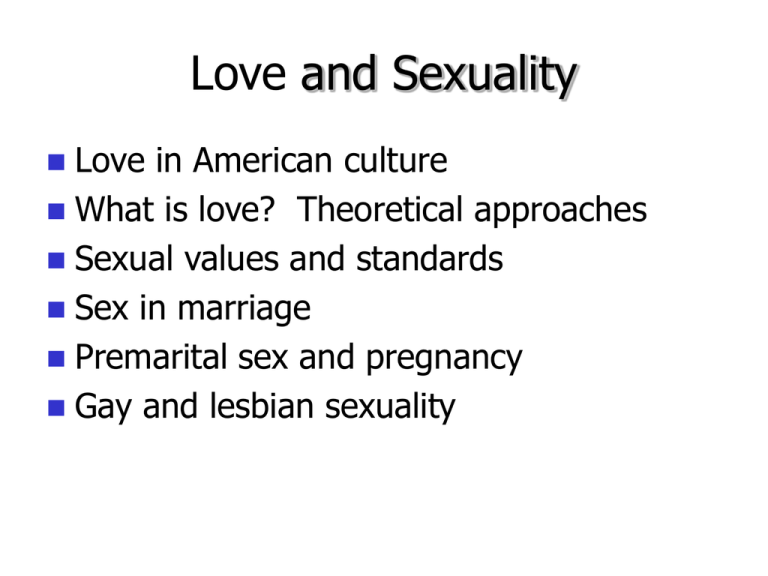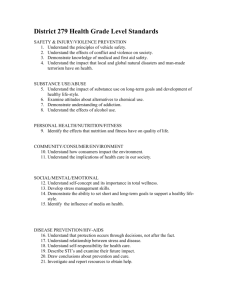
Love and Sexuality
Love in American culture
What is love? Theoretical approaches
Sexual values and standards
Sex in marriage
Premarital sex and pregnancy
Gay and lesbian sexuality
Historically
Love, sex, marriage were separate
19th century: love as pure, spiritual
Marriage as companionship
1920’s: sexual liberation
Today: love, sex before marriage
Cultural Views of Love
(Ann Swidler)
Mythic (Youthful)
–
–
–
–
Choice
Rebellion
Self-realization
Sexual expression
Prosaic (Mature)
–
–
–
–
Commitment
Attachment
Self-sacrifice
Restraint
What is Love? Schacter
Psychology of emotion
All emotions have 2 components
– Physiological arousal
– Definition of situation (labeling of emotion)
What is Love? Reiss: Wheel Theory
Sociocultural Background
Role conceptions
Intimacy
Rapport
Needs
Mutual
dependency
Selfrevelation
What is Love? Sternberg:
Triangular Theory
3 components to love relationships:
Intimacy
Passion
Decision/commitment
Triangles can take different shapes
“Match” b/t partners’ triangles is crucial
I
Infatuation
D/C
P
I
I
Empty love
P
D/C
Romantic
love
P
D/C
What is Love? Shaver:
Attachment Theory
Lover as attachment object
All love relationships are the same:
– Bond depends on AO’s response
– Happier if AO present
– Share more with AO
– Feel at one with AO
Three types of adult attachment
– Secure (56%)
– Anxious/ambivalent (19%)
– Avoidant (24%)
2 Stages of love
Passionate love
– Sexually charged, early in relationship
Companionate love
– Affection and partnership; long-lasting
Sexual Value Systems (Gecas and Libby)
Traditional-religious (began in colonial
times)
Romantic (late 19th century)
Recreational (historically applied to men;
more recently to women)
Utilitarian-predatory (probably always
existed)
Sexual Standards, 2002 (GSS)
Premarital sex: acceptable for adults, not young teens
Homosexuality: Divided opinions
Extramarital sex: not acceptable
Premarital Premarital sex Extramarital Homosexual
(teens 14-16) sex
sex
sex
Always wrong
27.3
72.4
79.1
52.9
Almost always
wrong
8.2
14.7
13.7
4.7
Sometimes wrong 19.9
8.8
4.3
6.9
Not wrong at all
4.2
2.1
31.8
44.5
Sex in Marriage
Is monogamous
Is part of wider life context
Involves decisions about parenthood
More likely to involve contraception
Contraceptive Use, 1995
Pregnancy Prevention
% using
Sterilization
27.9
Pill
17.3
Condom
13.1
Diaphragm, IUD, other
7.6
Periodic abstinence, “natural” FP
1.7
No Pregnancy Prevention
Pregnant, trying to conceive, post-partum, nonsurgically sterile, or not sexually active last 3 mo.
Sexually active, not pregnant or trying, not sterile,
and not contracepting (i.e., “taking chances”)
27.4
5.2
Teenage premarital sex
% of never-married teenagers who ever had intercourse, 2002
Females
Males
All 15-19 year-olds
45.5
45.7
Ages 15-17
30.3
31.3
Ages 18-19
68.8
64.3
Race/ethnic differences in teen sex
% of never-married teens, 15-17, who ever had
intercourse, 2002
70
60
50
White
40
Black
30
Hispanic
20
10
0
Female
Male
Age at first intercourse
Never married teens, ages 15-19, 2002
Female (%)
Male (%)
Under 15
28.6
32.0
15-16
48.0
42.0
17-19
23.3
26.0
# of partners, last 12 months
Never married teens, ages 15-19, 2002
70
60
50
40
Female
30
Male
20
10
0
None
1
2 or 3
4 or more
% not using contraception at first intercourse
Never married teens, ages 15-19, 2002
Age
Females
Males
Under 15
34.8
24.1
15-16
24.1
11.9
17-19
17.4
20.4
Percent of teen births before and after marriage, 1930-1994
Conclusions: Teen sexual behavior
Most teens have had sex by age 18
Boys, minorities start earlier
Typical age is around 15-16
Most have had 0 or 1 partners in 12 mos.
Sex is spontaneous, opportunistic, infrequent
Birth control is often overlooked
– 10% of teen girls 15-19 become pregnant each year
The Teen Pregnancy “Problem”
1/3 of teen pregnancies end in abortion
Teen pregnancy rate has declined, but
Most teen births occur outside of marriage
– Blacks: 96%
– Whites, Hispanics: 72%
Many teen mothers keep and raise
children today
Alternative Life-Course Theory
Giving birth as alternative entry to adulthood
– Maybe few other “good” choices
Grandmothers willing to raise grandchildren
Community accepts and supports this
Lack of “eligible” husbands
Consequences for Teenage Mothers
Lower education
Lower income
More likely to need public assistance
More likely to divorce
Some of these “disadvantages” due to
“selection effect”
Gay and Lesbian Sexuality
Sexual identity: self-identity as
heterosexual, homosexual, bisexual
Research supports biological component
– Studies of twins, brothers
– May run in families
Environmental factors may play a role
Controversial – has political implications
Emergence of “Homosexuality”
Ignored until late 19th century
Sexual acts divided into wrong/not wrong
OK to express intimate feelings for same sex
Late 1800s: anti-homosexuality campaign
– Defined as abnormal, mental illness
– Medical model stigmatized homosexuals
1948: Kinsey Report
50% of men reported erotic feeling
toward other men
1/3 had one experience with another man
Estimated 10% of men were exclusively
homosexual
More recent surveys: 4.1 % of men and
2.2 % women
Late 20th Century
1950’s: Homosexuals labeled “security
risks” by govt.
1960s: Civil rights, women’s movements term “gay” emerged
2003: Supreme Court struck down laws
against homosexual relations
Today: Much dissent about gay marriage
Consensual unions, domestic partners more
accepted
Objections to Gay Marriage
Don’t want to sanction “immoral” behavior
Seen as threat to traditional marriage
Cost of providing employee benefits to
more people
– already being done in many organizations
– actual costs have been small
Why Gay Marriage?
Gives gays more acceptance, support
Provides legal rights of spouse:
– Beneficiary of employee’s pension, insurance
– Joint income tax return
– Social Security benefits, inheritance
– Joint responsibility for children
– Visitation w/children after divorce
– Make decisions if spouse is unable
Summary: Love and Sexuality
Shift from economics to emotional bond
Growth of alternatives to marriage
Result:
– marriage as voluntary
– marriage based on love, compatibility
– sex before marriage
– family as individually defined
– More acceptance of homosexuality








